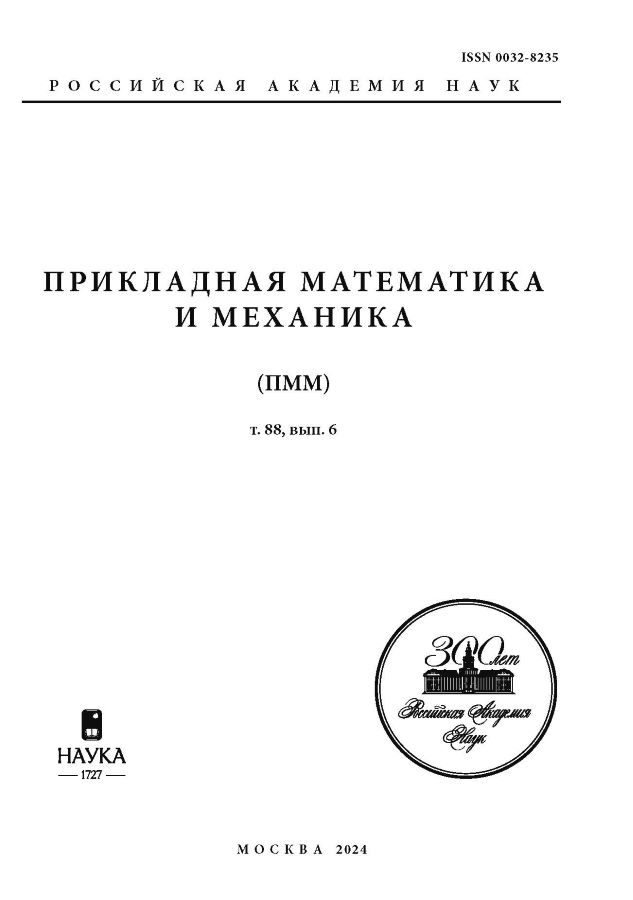Stability control of the supersonic boundary layer by laser pumping into a narrow local area. heat–insulated wall
- Authors: Grigoryev Y.N.1, Ershov I.V.1,2
-
Affiliations:
- Federal Research Center for Information and Computational Technologies
- Novosibirsk State Agrarian University
- Issue: Vol 88, No 6 (2024)
- Pages: 931-943
- Section: Articles
- URL: https://ruspoj.com/0032-8235/article/view/678443
- DOI: https://doi.org/10.31857/S0032823524060089
- EDN: https://elibrary.ru/IGNKGN
- ID: 678443
Cite item
Abstract
Effect of local supply of vibrational energy on the stability of a supersonic boundary layer on a plate is studied on the base of two-temperature system of equations for a single-mode vibrationally excited gas. The flight conditions in the atmosphere at an altitude of H = 15 km with a Mach number M = 4.5 were considered. It is shown that a source with a Gaussian power low dispersion profile located near the plate increases the temperature on the plate. When the source is localized at the upper boundary of the boundary layer, a significant area of the flow is heated. For two positions of the local source, neutral curves of two-dimensional temporal disturbances for the I and II Mack modes, as well as their increase increments, are calculated. Data on critical Reynolds numbers Reδ,cr and increment amplitudes were compared with similar data for a perfect gas without a source. It is shown that the source near the plate reduces the stability of the layer, and in the upper position, on the contrary, increases the stability compared to the reference case. The displacement of the laminar-turbulent transition zone under the action of vibrational energy source was estimated using the eN-method. For the upper position of the source, the shift of the beginning of the laminar-turbulent transition zone was 35%. The calculation results allow us to conclude that the local input of vibrational energy can become an effective method for controlling the stability of a supersonic boundary layer.
Keywords
Full Text
About the authors
Yu. N. Grigoryev
Federal Research Center for Information and Computational Technologies
Author for correspondence.
Email: grigor@ict.nsc.ru
Russian Federation, Novosibirsk
I. V. Ershov
Federal Research Center for Information and Computational Technologies; Novosibirsk State Agrarian University
Email: ivershov1969@gmail.com
Russian Federation, Novosibirsk; Novosibirsk
References
- Schlichting H. Boundary Layer Theory. N.Y.: McGraw-Hill, 1979. 817 p.
- Gaponov S.A., Ermolaev Yu.G., Zubkov N.N. et al. Investigation of the effect of heavy gas injection into a supersonic boundary layer on laminar–turbulent transition // Fluid Dyn., 2017, vol. 52, no. 6, pp. 769–776.
- Abdullaev A, Kotvitskii A, Moralev I, Ustinov M. On the possibility of cross–flow vortex cancellation by plasma actuators // Aerospace, 2023, vol. 10, no. 5, p. 469.
- Molevich N.E. Asymptotic analysis of the stability of a plane-parallel compressible relaxing boundary layer // Fluid Dyn., 1999, vol. 34, no. 5, pp. 675–680.
- Grigoryev Yu.N., Ershov I.V. Asymptotic estimate of stability of a supersonic boundary layer in a vibrationally excited gas on a plate // Fluid Dyn., 2019, vol. 54, no. 8, pp. 1020–1037.
- Gaponov S.A. Stability of a supersonic boundary layer with heat supply to a narrow band of the layer // Thermophys. Aeromech., 2021, vol. 28, no. 3, pp. 327–335.
- Manuilovich S.V., Ustinov M.V. Heat addition effect on the instability of the crossflow in a three-dimensional boundary layer // Fluid Dyn., 2014, vol. 49, no. 5, pp. 602–607.
- Grigor’ev Yu.N., Ershov I.V. Linear stability of the boundary layer of relaxing gas on a plate // Fluid Dyn., 2019, vol. 54, no. 3, pp. 295–307.
- Vincenti W.G., Kruger C.H. Introduction to Physical Gas Dynamics. Malabar: Krieger, 1986. 538 p.
- Alemasov V.E., Dregalin A.F., Tishin A.P. et al. Thermodynamic and Thermophysical Properties of Combustion Products. Vol. III. Moscow: VINITI AS of the USSR, 1973. 624 p. (in Russian)
- Ferziger J.H., Kaper H.G. Mathematical Theory of Transport Processes in Gases. Amsterdam: North-Holland Publ. Co., 1972. 550 p.
- Monchik L, Yun K.S., Mason E.A. Relaxation effects in transport properties of a sough spheres // J. Chem. Phys., 1963, vol. 38, pp. 1282–1287.
- Grigoryev Yu.N., Ershov I.V. Influence of vibrational excitation of the gas on the position of the laminar–turbulent transition region on a flat plate // J. Appl. Mech.&Tech. Phys., 2021, vol. 62, no. 1, pp. 11–17.
- Loitsyanskii L.G. Mechanics of Liquids and Gases. Oxford: Pergamon, 1966. 804 p.
- Grigoryev Yu.N., Gorobchuk A.G., Ershov I.V. Model of the boundary layer of a vibrationally excited dissociating gas // Thermophys. Aeromech., 2021, vol. 28, no. 5, pp. 635–647.
- Tables of Physical Quantities, Handbook / ed. by Kikoin I.K. Moscow: Atomizdat, 1976. 1008 p. (in Russian)
- Enochovich A.S. Handbook of Physics. Moscow: Education, 1990. 384 p.
- Grigoryev Y.N., Gorobchuk A.G., Ershov I.V. Calculations of supersonic boundary layer in the full and locally self-similar formulations // Comput. Technol., 2020, vol. 25, no. 2, pp. 50–62. (in Russian)
- Mack L.M. Boundary Layer Stability Theory. JPL Technical Rep., Document 900–277. Pasadena: California Instit. Technol., 1969. 272 p.
- Mack L.M. A numerical method for the prediction of high-speed boundary–layer transition using linear theory // Aerodyn. Anal. Requiring Advanced Comput. Part I. Washington: NASA, 1975. pp. 101–123.
Supplementary files














